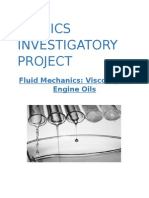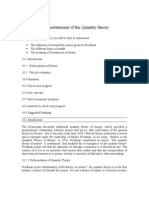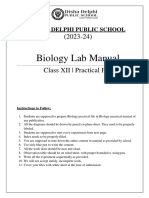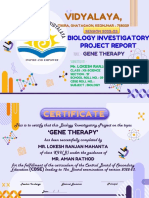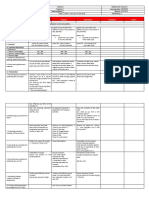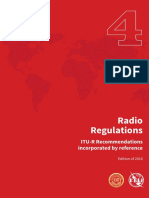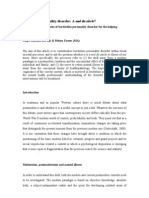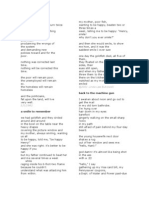Professional Documents
Culture Documents
II PU Biology Practical Viva Question and Answers
II PU Biology Practical Viva Question and Answers
Uploaded by
Holy Ghost0 ratings0% found this document useful (0 votes)
2K views6 pagesPollen grains germinate by absorbing water and nutrients to grow a pollen tube through the style to the ovary. Germ pores allow this growth and release of male gametes. A 10% sucrose solution is commonly used to induce pollen germination in experiments. The percentage of pollen germination is calculated by counting germinated and total pollen grains under a microscope. Acetocarmine stain is used to observe plant and animal cell nuclei and structures. Mitosis results in two daughter cells with the same number of chromosomes, passing through prophase, metaphase, anaphase and telophase, while cytokinesis divides the cytoplasm. Homologous organs have a similar origin and structure but different
Original Description:
Original Title
viva questions
Copyright
© © All Rights Reserved
Available Formats
PDF, TXT or read online from Scribd
Share this document
Did you find this document useful?
Is this content inappropriate?
Report this DocumentPollen grains germinate by absorbing water and nutrients to grow a pollen tube through the style to the ovary. Germ pores allow this growth and release of male gametes. A 10% sucrose solution is commonly used to induce pollen germination in experiments. The percentage of pollen germination is calculated by counting germinated and total pollen grains under a microscope. Acetocarmine stain is used to observe plant and animal cell nuclei and structures. Mitosis results in two daughter cells with the same number of chromosomes, passing through prophase, metaphase, anaphase and telophase, while cytokinesis divides the cytoplasm. Homologous organs have a similar origin and structure but different
Copyright:
© All Rights Reserved
Available Formats
Download as PDF, TXT or read online from Scribd
Download as pdf or txt
0 ratings0% found this document useful (0 votes)
2K views6 pagesII PU Biology Practical Viva Question and Answers
II PU Biology Practical Viva Question and Answers
Uploaded by
Holy GhostPollen grains germinate by absorbing water and nutrients to grow a pollen tube through the style to the ovary. Germ pores allow this growth and release of male gametes. A 10% sucrose solution is commonly used to induce pollen germination in experiments. The percentage of pollen germination is calculated by counting germinated and total pollen grains under a microscope. Acetocarmine stain is used to observe plant and animal cell nuclei and structures. Mitosis results in two daughter cells with the same number of chromosomes, passing through prophase, metaphase, anaphase and telophase, while cytokinesis divides the cytoplasm. Homologous organs have a similar origin and structure but different
Copyright:
© All Rights Reserved
Available Formats
Download as PDF, TXT or read online from Scribd
Download as pdf or txt
You are on page 1of 6
II PU Biology practical viva question and answers
Percentage of Pollen Germination
1.What is pollen germination?
Pollen grains germinate when they absorb nutrients and water and grow a pollen tube
from the style to the ovary part through one of the germ pores.
2. What is a germ pore?
Germ pores are the regions in outer wall of pollen grain (exine) where sporopollenins are
absent. They give rise to pollen tube and release male gametes during fertilization.
3. Name the solution used to induce pollen germination.
Sucrose Solution (10%)
4. Which formula is used to calculate the germination of pollen germination?
% Pollen germination= No. of germinated pollen grains in a field of microscope (n) / No. of
pollen in a
field of microscope (N) X 100.
Pollen Tube Growth on Stigma
5. Name the parts of a pistil or carpel.
Stigma, Style, Ovary and Ovule.
6. Where does pollen germination occur in a flower?
Pollen grains germinate on Stigma.
7. Which stain is used to observe the growth of pollen tube?
Cotton Blue Stain.
Transverse Section of Ovary
8. What is a locule?
Locule is a small cavity or chamber within an ovary of a flower.
9. What is pentalocular ovary?
Ovary with 5 locules
10. What is placentation?
The arrangement of ovules within the ovary is called placentation.
11. What is axile placentation?
The placenta which is located at the centre and the ovules are attached to it.
Nuclear Staining
12. In what shape the cells of onion epidermal peel are appeared?
Rectangular shaped cells
13. How many nuclei are present in a cell of epidermal peel of onion?
One nucleus in each cell
14. Name the stain used for nuclear staining?
Acetocarmine stain
Mitosis using onion root tip
15. What is mitosis?
A type of cell division that results in two daughter cells each having the same number of
chromosomes as that of parent cell. It is also called as equational division.
16. Define karyokinesis.
Karyokinesis is the division of cell nucleus during mitosis.
17. Name the phases of Karyokinesis.
Prophase, Metaphase, Anaphase and Telophase.
18. Define cytokinesis.
Cytokinesis is the division of cytoplasm of a parent cell into two daughter cells.
19. In which phase of karyokinesis, the sister chromatids are arranged in the equatorial
plane of spindle fibres?
During metaphase of karyokinesis
Determination of pH of water and soil sample
20. Which component of the soil or water sample determines the pH?
The number of hydrogen ions and hydroxide ions present in the solution determines the
pH of that solution or sample.
21. What is the range of acidic pH, basic pH and the neutral pH?
Acidic pH- Below 7
Neutral pH- 7
Basic pH- Above 7
T.S. of Mammalian Testes
22.Name the different types of cells found in the mammalian testes.
Sertoli cells and Leydig (interstitial cells) cells.
23. In which part of the testis interstitial cells are present?
In Seminiferous tubules.
24. To which cells of the seminiferous tubules the spermatozoa are attached?
Attached to Sertoli cells for their nourishment.
25. Name the endocrine cells of testes which secrete testosterone.
Leydig cells.
26. What are Sertoli cells?
Sertoli cells are also called ‘nurse cells.’ It is the part of a seminiferous tubule and it helps
in the process of spermatogenesis.
T.S. of Mammalian Ovary
27. Name the different developmental stages of ovarian follicles.
Primordial follicle, Primary follicle, Secondary follicle, Tertiary follicle and Graffian
follicle.
28. Name the cavity present in the Graffian follicle.
Antrum.
29. What is Corpus Albicans?
If the egg is not fertilized, the corpus luteum is degenerated and is transformed into a
white scar called Corpus albicans.
V.S. of a Mammalian Blastula
30. Name the cavity present in the blastocyst?
Blastocoel.
31. What are cells of Rauber?
They are trophoblast cells that are in contact with the inner mass of blastocyst.
32. What is trophoblast?
Trophoblast are the cells that make up the outer layer of a blastocyst, which feeds the
embryo and eventually becomes a major part of the placenta.
33. Which component of the blastocyst develops into embryo proper?
The inner thickened cells in the wall of blastocyst develops into embryo.
V.S. of ovary showing female gametophyte
34. How many cells and nuclei are present in a typical female gametophyte of angiosperms?
The female gametophyte or embryo sac has 7 cells and 8 nuclei.
35. Name the two poles of an embryo sac.
Micropylar end and Chalazal end.
36. At which end of an embryo sac, egg apparatus is present?
Micropylar end.
37. Name the cell of an embryo sac that has two polar nuclei. ,
Central cell.
Disease causing organisms
38. Name the causative organism of amoebic dysentery.
Entamoeba histolytica.
39. Name the causative organism of malaria.
Plasmodium vivax.
40. Name the infective stage of plasmodium.
Sporozoites.
41. Name the causative organism of Ascariasis and Ringworm.
Ascariasis- Ascaris lumbricoids
Ringworm- Trichophyton rubrum
Hydric and Xeric adaptations in plants
42. Mention any one xeric adaptation in opuntia.
The leaves are modified into spines to reduce transpiration.
43. What is called buoyancy?
Buoyancy is the force that causes the object to float in a fluid.
44. Which tissue helps in buoyancy in aquatic plants?
Aerenchyma provides buoyancy to aquatic plants.
Hydric and Xeric adaptations in animals
45. Mention any one aquatic adaptation of fish/prawn/frog.
Fish: Gills help in respiration inside the water.
Prawn: The stream lined body helps in swimming.
Frog: Mucus glands are present in skin to keep the skin moist.
46. Mention any one xeric adaptation in camel/squirrel.
Camel: Fat stored in hump helps it to survive long periods without food and water.
Squirrel: Squirrels survive the heat through a sort of reverse hibernation called
aestivation.
Homologous and Analogous organs in plants and animals
47. What are homologous organs?
Homologous organs are the organs of different animals that have similar origin and
structure but differ in their functions.
48. Why are scale leaves of onion and spines of opuntia called homologous organs?
Scale leaves of onion and spines of opuntia are modified leaves but functionally different
from each other, so they are called homologous organs.
49. What are analogous organs?
The organs of different animals that have similar function but differ in their origin and
structure.
50. What is the function of rhizome and carrot?
The primary function of rhizome (ginger) and carrot is the storage of nutrients that makes
the plant to survive an unfavourable season.
You might also like
- Albania The Bradt Travel Guide - NodrmDocument300 pagesAlbania The Bradt Travel Guide - NodrmKusaila100% (4)
- INVESTIGATORY Project - Dispersal of Seeds 1 (Final)Document27 pagesINVESTIGATORY Project - Dispersal of Seeds 1 (Final)Uma100% (3)
- Biology Investigatory ProjectDocument19 pagesBiology Investigatory ProjectRapidtg 1965100% (8)
- CBSE Project Physics - Dry Battery ChargerDocument11 pagesCBSE Project Physics - Dry Battery ChargerTanish72% (18)
- Physics Investigatory ProjectDocument19 pagesPhysics Investigatory ProjectArpit Joshi76% (21)
- Restatement of Quantity Theory of MoneyDocument6 pagesRestatement of Quantity Theory of MoneyAppan Kandala Vasudevachary67% (3)
- II PUC Biology - Viva Voce QuestionsDocument10 pagesII PUC Biology - Viva Voce QuestionsdharshanNo ratings yet
- CBSE Class 12 Biology Practicals 2023 24Document2 pagesCBSE Class 12 Biology Practicals 2023 24Abdelrahman Khaled50% (4)
- Class 12 Biology Practicals - I (2022-23)Document10 pagesClass 12 Biology Practicals - I (2022-23)Dwip Das100% (1)
- Homologous and Analogous Organs Class Xii PracticalDocument4 pagesHomologous and Analogous Organs Class Xii PracticalAnushree100% (3)
- Free Online Guide - Class 12 Biology Viva Voce Questions For Practical Experiments and Projects - 1-13Document2 pagesFree Online Guide - Class 12 Biology Viva Voce Questions For Practical Experiments and Projects - 1-13anam sadiq100% (2)
- Stem Cell ProjectDocument23 pagesStem Cell ProjectTD Harini0% (1)
- Meiosis in Onion Bud Cell or Grasshopper Testis Through PermanentDocument5 pagesMeiosis in Onion Bud Cell or Grasshopper Testis Through PermanentAnurag100% (1)
- Biology Investigatory ProjectDocument17 pagesBiology Investigatory ProjectAnuj Kamble100% (5)
- Karan ProjectDocument12 pagesKaran ProjectAnshika SinghNo ratings yet
- Exp No 8 Controlled PollinationDocument3 pagesExp No 8 Controlled PollinationShadab Ahmad0% (2)
- CBSE Class 12 Biology Revision Notes Chapter-02 Sexual Reproduction in Flowering PlantsDocument11 pagesCBSE Class 12 Biology Revision Notes Chapter-02 Sexual Reproduction in Flowering PlantsNada NavasNo ratings yet
- 12 Chemistry NcertSolutions Chapter 11 IntextDocument10 pages12 Chemistry NcertSolutions Chapter 11 IntextAditya kaushikNo ratings yet
- Bio ProjectDocument7 pagesBio ProjectSatyaranjan SahuNo ratings yet
- BIO PRACTICAL For Class 12Document2 pagesBIO PRACTICAL For Class 12Tushar PaulNo ratings yet
- Project On Pollen Viability Class 12Document9 pagesProject On Pollen Viability Class 12Prithvi Kumar67% (3)
- The Biology Project: Mendelian Genetics: Done By: B.Mithun Xii-ADocument28 pagesThe Biology Project: Mendelian Genetics: Done By: B.Mithun Xii-Apriya balaji100% (1)
- Biology Investigatory Project 12c09 - Sai Arjun.mDocument26 pagesBiology Investigatory Project 12c09 - Sai Arjun.mVVM. S.4669100% (1)
- Bio Investigatory ProjectDocument14 pagesBio Investigatory ProjectMohd Akram Ameen100% (4)
- Bot-Morphology New Families AssignmentsDocument21 pagesBot-Morphology New Families AssignmentsJanani Ka57% (7)
- Class 12 Biology Lab Manual Practical Content 2023-24-1Document14 pagesClass 12 Biology Lab Manual Practical Content 2023-24-1Geetanjali Saraswat100% (4)
- Biology Investigatory Project 121126091042Document12 pagesBiology Investigatory Project 121126091042ajitsingh220867% (3)
- Model Specimens Showing Symbiotic Association in Root Nodules of Leguminous PlantsDocument3 pagesModel Specimens Showing Symbiotic Association in Root Nodules of Leguminous PlantsBisweswar garaiNo ratings yet
- Physics Investigatory On Electromagnetic InductionDocument20 pagesPhysics Investigatory On Electromagnetic InductionUsha Pachu38% (8)
- Biology Practical Class 12Document2 pagesBiology Practical Class 12ManishNo ratings yet
- Experiment 2Document2 pagesExperiment 2kavikiran0% (1)
- Haloalkanes and Haloarenes-Previous Years QuestionsDocument9 pagesHaloalkanes and Haloarenes-Previous Years QuestionsAkshat GuptaNo ratings yet
- PollinationDocument22 pagesPollinationNAVEEN DHIMAN100% (1)
- Biology INVESTIGATORY PROJECT REPORT ON GENE THERAPYDocument32 pagesBiology INVESTIGATORY PROJECT REPORT ON GENE THERAPYLokesh Ranjan Mahanta100% (1)
- Isolation of DNA From Plant Materials: ExperimentsDocument2 pagesIsolation of DNA From Plant Materials: Experimentshakava100% (1)
- Biology Investigatory ProjectDocument26 pagesBiology Investigatory ProjectVVM. S.4669No ratings yet
- Hariom Kumar RoyDocument24 pagesHariom Kumar RoyRajeev Kumar Roy0% (1)
- Biology Investigatory ProjectDocument19 pagesBiology Investigatory ProjectPriyanks Rout50% (2)
- Topic-Osmosis, Reverse Osmosis and Its Applications: Chemistry Investigatory ProjectDocument21 pagesTopic-Osmosis, Reverse Osmosis and Its Applications: Chemistry Investigatory ProjectAmmar Adil100% (2)
- Physics Investigatory ProjectDocument12 pagesPhysics Investigatory ProjectHarsh Mande100% (3)
- Xamidea Sexual Reproduction in Flowering PlantsDocument31 pagesXamidea Sexual Reproduction in Flowering PlantsShireen SuhailNo ratings yet
- Biology Investigatory Project PDFDocument19 pagesBiology Investigatory Project PDFAnargha BoseNo ratings yet
- Making A Plastic From StarchDocument14 pagesMaking A Plastic From StarchMonalisha Gujar100% (1)
- Biology ProjectDocument14 pagesBiology ProjectKalika Mohapatra67% (3)
- Investigatory Project ON Viral Diseases: Submitted ToDocument14 pagesInvestigatory Project ON Viral Diseases: Submitted ToKARTHIK M100% (1)
- Microbes in Human Welfare ProjectDocument36 pagesMicrobes in Human Welfare ProjectMonika S100% (2)
- Acknowledgement (Bio) PDFDocument1 pageAcknowledgement (Bio) PDFakashNo ratings yet
- BIO EXP 1 and 2Document7 pagesBIO EXP 1 and 2Bala Murugan.VNo ratings yet
- Bio ProjectDocument13 pagesBio ProjectFeLiX JeremyNo ratings yet
- Chemistry ProjectDocument19 pagesChemistry ProjectMuhammed Äméèñ100% (4)
- Biology Investigatory ProjectDocument12 pagesBiology Investigatory ProjectSakshi Godara86% (14)
- Biology Investigatory Project On Pollination of FlowersDocument26 pagesBiology Investigatory Project On Pollination of FlowersMohamed Laqin100% (2)
- Physicsinvestigatoryproject 170908150740Document20 pagesPhysicsinvestigatoryproject 170908150740Nx GamingYTNo ratings yet
- Class XII Biology PracticalsDocument41 pagesClass XII Biology PracticalsChandra Nath Chowdhury100% (1)
- FamiliesDocument25 pagesFamiliesmanjuharish2414100% (3)
- Reproductivehealthppt 140331090032 Phpapp02Document25 pagesReproductivehealthppt 140331090032 Phpapp02Antarip Acharya100% (2)
- Bio Class 12Document20 pagesBio Class 12Akanksha TiwariNo ratings yet
- Microbes Biology ProjectDocument19 pagesMicrobes Biology ProjectArpit Gupta100% (2)
- Viva Questions BioDocument2 pagesViva Questions BioTejaswini S.kNo ratings yet
- Paper 9th Biology Annual MutaqaddimmDocument3 pagesPaper 9th Biology Annual MutaqaddimmmunawarNo ratings yet
- Cells Quiz Bio AnswersDocument4 pagesCells Quiz Bio AnswerslatteNo ratings yet
- 02 Biology Viva Questions 2023-24 B South FinalDocument2 pages02 Biology Viva Questions 2023-24 B South Finalvarshithajadhav6No ratings yet
- Lecture 2 Properties of Milk and Its ComponentsDocument10 pagesLecture 2 Properties of Milk and Its ComponentsAyush Chopra0% (1)
- Mainstreaming Physical Activity in Landscape Architecture DesignDocument176 pagesMainstreaming Physical Activity in Landscape Architecture DesignAlgi FahriNo ratings yet
- CORE Unit 1 Classroom ManagementDocument16 pagesCORE Unit 1 Classroom ManagementJelena MitrovicNo ratings yet
- Cô Mai Phương - Đề chuẩn 13 - File word có lời giải chi tiếtDocument21 pagesCô Mai Phương - Đề chuẩn 13 - File word có lời giải chi tiếtMinh Đức NguyễnNo ratings yet
- Manorama Profile 22.8.13Document1 pageManorama Profile 22.8.13Vilas KholeNo ratings yet
- Corporate Governance and Role of Directors"Document21 pagesCorporate Governance and Role of Directors"Navin sharma100% (1)
- DLL Science Quarter 4Document33 pagesDLL Science Quarter 4CedronicoPerochoNo ratings yet
- Course Codes With Pre ReqDocument4 pagesCourse Codes With Pre ReqUlfat RasoolNo ratings yet
- LIMAB Steel Tubes EngDocument8 pagesLIMAB Steel Tubes EngAnees Ur RehmanNo ratings yet
- General Category: RESULT of PMT-2010 (Screening) ExaminationDocument17 pagesGeneral Category: RESULT of PMT-2010 (Screening) ExaminationSoumya RayNo ratings yet
- Tabula Py Readthedocs Io en LatestDocument33 pagesTabula Py Readthedocs Io en LatestMatalus MasterNo ratings yet
- PP Vs Molejon Acts of Lasciviousness Vs Lascivious ConductDocument9 pagesPP Vs Molejon Acts of Lasciviousness Vs Lascivious ConductRichard Rey CaminadeNo ratings yet
- UTS Self Awareness Answer KeyDocument4 pagesUTS Self Awareness Answer KeyAngelie JalandoniNo ratings yet
- Classified Advertising: NurseDocument3 pagesClassified Advertising: NurseudmanNo ratings yet
- Michie Government and The City PDFDocument395 pagesMichie Government and The City PDFargayuNo ratings yet
- RR 2016 VolIV E A5Document546 pagesRR 2016 VolIV E A5Aldrin VillanuevaNo ratings yet
- A Macroscale Model For Low Density Snow Subjected To Rapid LoadingDocument19 pagesA Macroscale Model For Low Density Snow Subjected To Rapid LoadingAnonymous eCD5ZR100% (1)
- Complaint in Walls, Et Al. v. Sanders, Et Al., 4:24-CV-270-KGB.Document56 pagesComplaint in Walls, Et Al. v. Sanders, Et Al., 4:24-CV-270-KGB.egodinezfr100% (1)
- Integrated Smart Shoe For Blind People: M.V.S.Divija, M.Rohitha, Meghana.T, Monisha.H, Prof - RaveendraDocument5 pagesIntegrated Smart Shoe For Blind People: M.V.S.Divija, M.Rohitha, Meghana.T, Monisha.H, Prof - RaveendraSachin ShivannavarNo ratings yet
- Borderline Personality DisorderDocument9 pagesBorderline Personality DisorderLCNo ratings yet
- Admin Service - Vehicle Management - ST - AI - 2006 - 1 - Policy On Provision and Use of Official CarsDocument3 pagesAdmin Service - Vehicle Management - ST - AI - 2006 - 1 - Policy On Provision and Use of Official CarsMarcel GigelNo ratings yet
- BUPRG Note - Black Start DGDocument12 pagesBUPRG Note - Black Start DGvinay.vishwakarmaNo ratings yet
- Investments. Lecture Notes 2Document34 pagesInvestments. Lecture Notes 2Oona NiallNo ratings yet
- MM Task - CH7 - Analyzing Business Markets - Kel 6 - EMBA B 41 ADocument29 pagesMM Task - CH7 - Analyzing Business Markets - Kel 6 - EMBA B 41 AHaryadi WidodoNo ratings yet
- Drought in Abudi M02Document1 pageDrought in Abudi M02Muhammad JawadNo ratings yet
- 2.2.3 Spy Training 187KBDocument2 pages2.2.3 Spy Training 187KBEyemanProphetNo ratings yet
- Vocabulary of Banking and FinanceDocument2 pagesVocabulary of Banking and Financemarieme.sall4No ratings yet
- Buk PoemsDocument16 pagesBuk PoemsEnrike NájeraNo ratings yet




